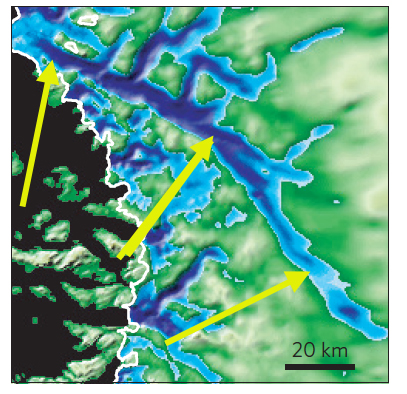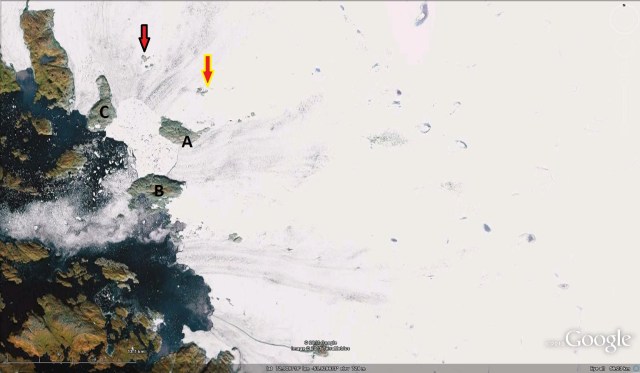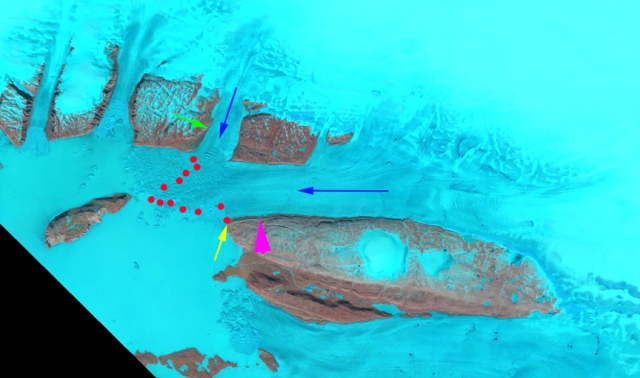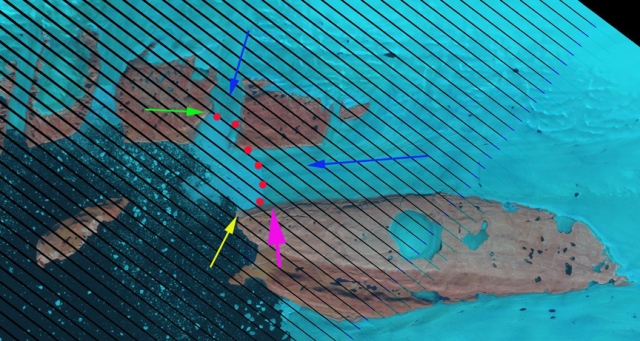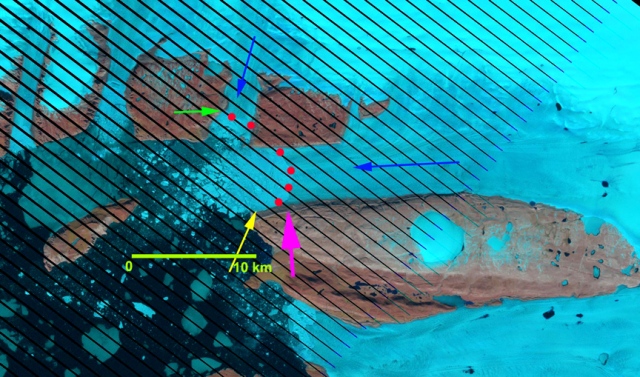Tracy Gletscher in Northwest Greenland has experienced an accelerated retreat since 2000. Here we utilize Landsat imagery from 1987-2013 to examine this retreat. Rignot et al (2001) identified the centerline velocity as it entered the final fjord reach, 25-30km from the terminus, of 500 m/year, with a thickness of 1200 meters.
Sakakibara (2011) noted an increased retreat of 3.1 km from 2000-2011. The noted an acceleration of the glacier from 1988 to 2011 with velocities of 2 km per year 10 km behind the calving front. The 1991 geologic map of the area from GEUS indicates the tributary from the north, Farquhar Glacier, joined with the Tracy Gletscher at the terminus.  In the Landsat images the ice front of both of these glacier is indicated by red dots. The 2013 terminus location of Tracy Gletscher is indicated by a pink arrow and the yellow arrow indicates the tip of a peninsula where the southern margin of Tracy Gletscher was in 1988. There is a quite a number of large icebergs beyond the terminus in 1987, 1991 and 2000. The termini are still joined in 2000. By 2009 the glaciers are separated and have retreated into their respective fjords. By 2013 the main Tracy terminus is aligned with a kink in the lateral moraine, pink arrow. The retreat since 1987 of the main terminus has been 3 km on the southern margin, 5.5 km on the northern margin and 9 km for the center tongue. With most all of the retreat occurring since 2000. This higher retreat rate for the 1992-2000 period as the tongue collapsed is noted by Moon and Joughin (2008). The retreat is similar to that of nearby Dodge and Storm Glacier, and Kong Oscar Glacier. This glacier falls into a long list of retreating glaciers of all types in all regions of Greenland.
In the Landsat images the ice front of both of these glacier is indicated by red dots. The 2013 terminus location of Tracy Gletscher is indicated by a pink arrow and the yellow arrow indicates the tip of a peninsula where the southern margin of Tracy Gletscher was in 1988. There is a quite a number of large icebergs beyond the terminus in 1987, 1991 and 2000. The termini are still joined in 2000. By 2009 the glaciers are separated and have retreated into their respective fjords. By 2013 the main Tracy terminus is aligned with a kink in the lateral moraine, pink arrow. The retreat since 1987 of the main terminus has been 3 km on the southern margin, 5.5 km on the northern margin and 9 km for the center tongue. With most all of the retreat occurring since 2000. This higher retreat rate for the 1992-2000 period as the tongue collapsed is noted by Moon and Joughin (2008). The retreat is similar to that of nearby Dodge and Storm Glacier, and Kong Oscar Glacier. This glacier falls into a long list of retreating glaciers of all types in all regions of Greenland. 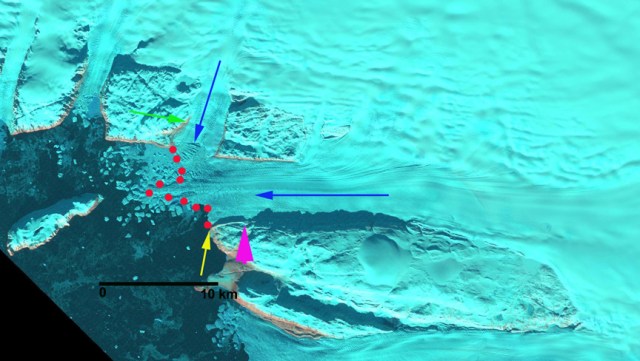
Tag: nw greenland glacier retreat
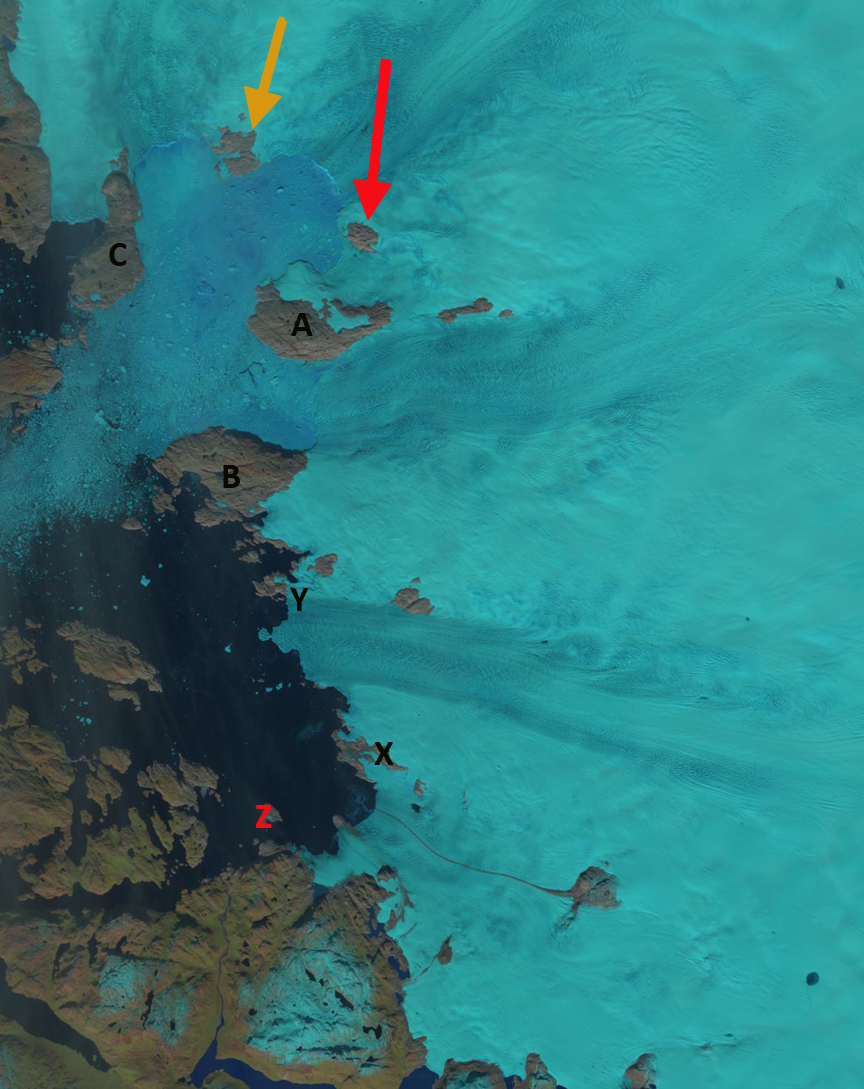
Upernavik Glacier Retreat, NW Greenland
Box and Decker (2011) focused on the changes in the terminus of 39 Greenland Outlet glaciers from 2000-2010. Of these 35 had experienced net loss with the collective loss of 1593 km2 over the last decade. (Box and Decker, 2011). The retreat has occurred irrespective of the different characteristics of various glaciers (Bailey and Pelto, SkS) One of the glaciers in this group is Upernavik Glacier on the NW Greenland Coast. The Upernavik Glacier refers today refers to an increasing number of separate termini that were one termini up through 1950. Jason Box of Ohio State focused on the different termini in a 2008 post, commenting on the separation of termini A and B. Here we will focus on the development of two new islands between 2002 and 2010 due to the retreat of termini C as identified by Box and Benson in the image below. There are three marginal rock islands at the icecap periphery that are consistently labeled in the images below A, B and C. In addition the two arrows indicate two former nunataks, surrounded by ice in the 2002 Landsat image (top image below), and are now becoming rock islands at the glacier front in both Landsat 2010 (middle two images) and MODIS 2011 image (bottom). In the closeup Landsat image the glacier front is indicated in orange, beyond the terminus the fjord is still filled with considerable glacier debris that has calved. The black lines in the image are the uncorrected scan lines. A 2013 Landsat image indicates changes along outlet A as island at Point X, Y and Z emerge from the ice compared to 2002.
There are three marginal rock islands at the icecap periphery that are consistently labeled in the images below A, B and C. In addition the two arrows indicate two former nunataks, surrounded by ice in the 2002 Landsat image (top image below), and are now becoming rock islands at the glacier front in both Landsat 2010 (middle two images) and MODIS 2011 image (bottom). In the closeup Landsat image the glacier front is indicated in orange, beyond the terminus the fjord is still filled with considerable glacier debris that has calved. The black lines in the image are the uncorrected scan lines. A 2013 Landsat image indicates changes along outlet A as island at Point X, Y and Z emerge from the ice compared to 2002. 




2013 Landsat image
Google Earth currently has an image that predates the development of the new island as well. This is not the only new island in Greenland by any means. Warming Island on the east coast has gained notoriety. It is seen below in a nice August 2010 Landsat image.  Box and Decker (2011) note that ice loss for Upernavik Glacier’s combined termini was 7.9 square kilometers per year from 2000-2010, in Table 2. For the 2002 to 2010 period it is evident the Upernvavik terminus C lost at least 35 square kilometers as the two new islands begin to develop, mostly between 2002 and 2008. This glacier follows the pattern of Umiamako Glacier and Jakobshavn Glacier. It also is worth noting it has a deep bed that extends well under the ice sheet as observed by Morligheim et al (2014).
Box and Decker (2011) note that ice loss for Upernavik Glacier’s combined termini was 7.9 square kilometers per year from 2000-2010, in Table 2. For the 2002 to 2010 period it is evident the Upernvavik terminus C lost at least 35 square kilometers as the two new islands begin to develop, mostly between 2002 and 2008. This glacier follows the pattern of Umiamako Glacier and Jakobshavn Glacier. It also is worth noting it has a deep bed that extends well under the ice sheet as observed by Morligheim et al (2014). 